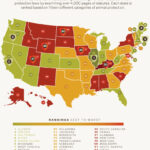In the realm of animal rights advocacy, watching perpetrators face justice for acts of cruelty evokes a mixture of relief and intrigue. A particularly disquieting observation is the frequency with which certain offenders are charged with multiple counts of animal cruelty within a single case. This phenomenon raises pressing questions about the nature of these offenses and the underlying societal dynamics that drive such egregious behavior.
To comprehend the rationale behind the imposition of multiple counts of animal cruelty, it is critical to dissect the legal framework governing animal welfare laws. Typically, animal cruelty is delineated into varied classifications, including neglect, physical abuse, and abandonment. Each separate act of cruelty can constitute an individual count, encapsulating the multifaceted realities of animal abuse. For instance, a single perpetrator may leave numerous animals in deplorable conditions, leading to several counts reflecting their distinct cases of misconduct.
When a person is charged with multiple counts, it serves to highlight the scope of their actions. A situation may arise where a pet owner has kept a significant number of dogs without proper care – overcrowded conditions, insufficient food, and lack of vet visits compounded over time. Each animal’s suffering can be classified as a separate, prosecutable count of cruelty. Therefore, in such instances, the plea for accountability is not merely about punitive measures; it signifies a demand for recognition that animals are indeed sentient beings deserving of protection and empathy.
Yet, this leads us to a larger and more troubling query: what drives individuals to commit such barbaric acts toward animals? A prevailing theory posits that a significant portion of animal cruelty offenders often display a disturbing pattern of psychological dysfunction. Research indicates that many individuals who partake in animal cruelty manifest antisocial behaviors, emotional detachment, or a history of abusive tendencies extending beyond their interactions with animals. Thus, these multifaceted counts of charges against them might serve as an revealing snapshot into their disturbed psyche.
Another vital aspect to consider is the societal environment fostered around the offenders. Oftentimes, people engaged in animal neglect or cruelty come from backgrounds that lack compassion or understanding of animal welfare. In many cases, socioeconomic factors play a detrimental role, wherein financial strain leads individuals to neglect the essential care required for their pets. When multiple animals are involved, the sheer number of charges emanates from a systemic failure — an intersection of poverty, education, and access to resources that ultimately leaves animals vulnerable to neglect.
Moreover, the increasing trends in both awareness and legislation surrounding animal rights have compelled law enforcement and legal entities to take a more rigorously punitive stance against violators of animal cruelty laws. When faced with multiple counts, prosecution teams often utilize these circumstances to advocate for harsher penalties, thus fostering a more robust legal framework to deter future offenders. The ramifications of this approach are twofold: while it serves justice for the animals affected, it also catalyzes a broader conversation regarding societal responsibilities toward animal care and the importance of interventions before neglect occurs.
The prosecution’s decision to introduce multiple counts against an offender opens conversations on preventative measures. Educating the public on animal welfare, providing resources for pet care, and encouraging community-supported programs are essential in mitigating the risks associated with animal cruelty. It is necessary to emphasize that each count filed against an offender echoes a lost opportunity for an animal to receive care and affection.
Indeed, the psychology of animal cruelty is complex and varied. Scholars in criminology have explored how certain individuals find gratification in exerting power over those deemed weaker. The emotional detachment often displayed by offenders can be traced back to their early socialization. A history marked by violence or neglect can manifest later in life, leading to abusive behavior towards pets. Understanding such psychological undercurrents is critical to reform efforts aimed at curbing animal cruelty. It is essential for society to not only punish but also rehabilitate offenders. By delving into the motivations behind these crimes, programs can be designed to thwart such behaviors and foster respect toward all living beings.
While multiple counts of animal cruelty may appear to be a straightforward legal mechanism, they reveal a multifaceted discourse involving societal, psychological, and educational dynamics. Each count represents a glaring transgression against not just the animals themselves but also the values we uphold as a compassionate society.
Ultimately, as animal advocates continue to demand change, it is paramount to enhance awareness about these deeper-rooted issues. Engaging with local communities, reforming legislation, and fostering a culture of compassion can serve as the bedrock for preventing futures where individuals must face multiple charges related to animal cruelty.
Eradicating animal cruelty demands a commitment to justice, rehabilitation, and education. The multiple counts of cruelty against a single offender must act as a catalyst for broader systemic change, transforming not just legal repercussions but societal perceptions and practices towards animal welfare. An empowered society won’t merely react to cruelty; it will proactively nurse and nurture the beings with whom we share this world.







